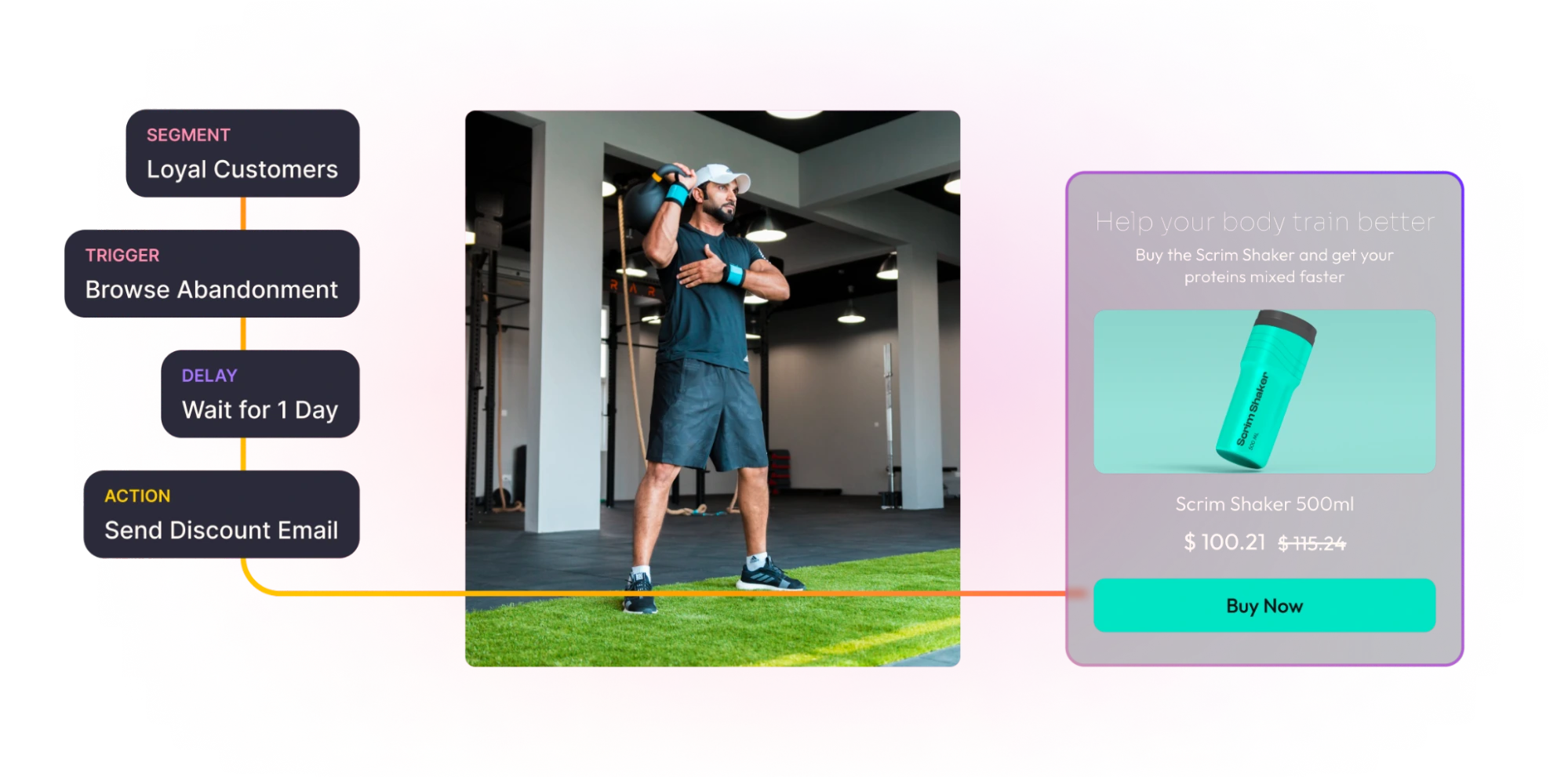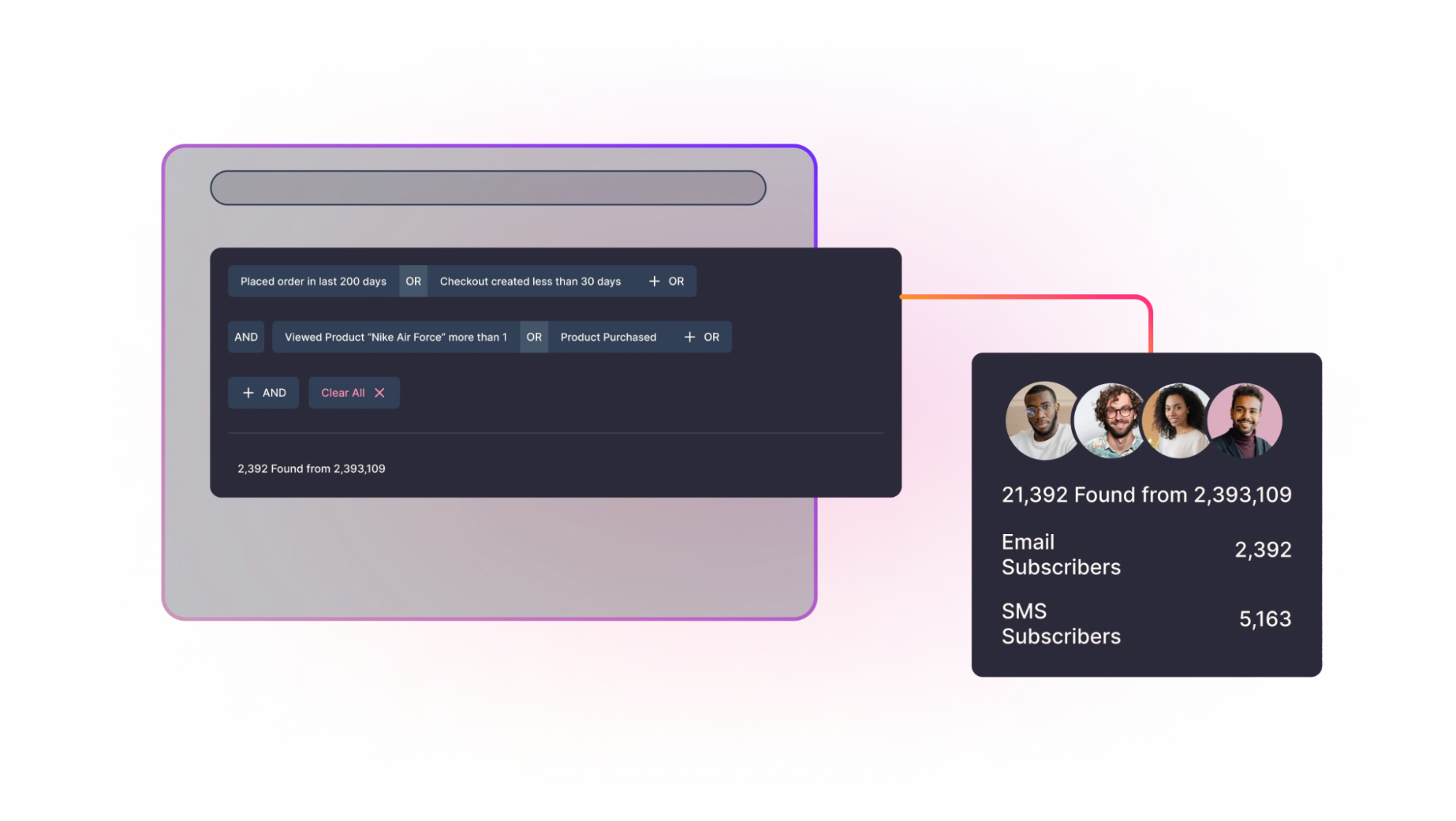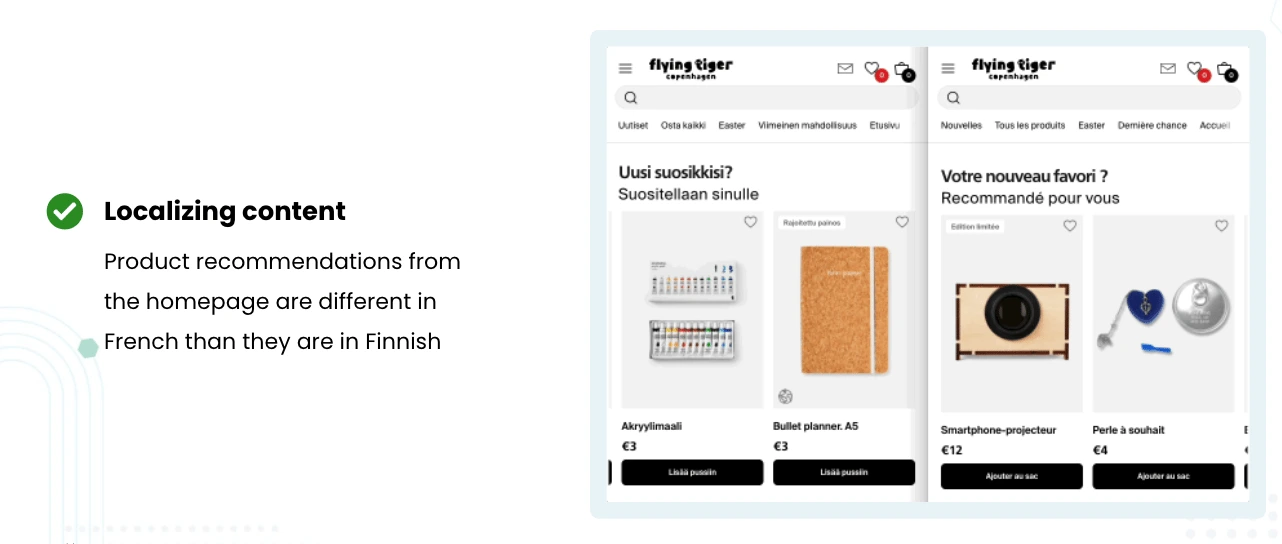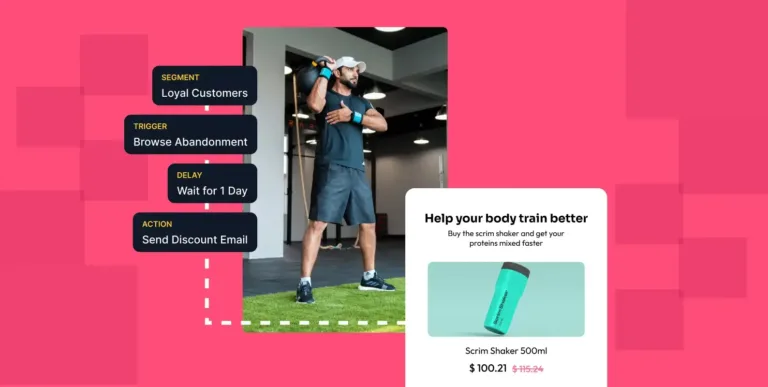The online retail industry is growing at an unprecedented rate. Research indicates that the global Ecommerce industry is expected to grow 8.9% in 2023, with sales totaling $5.9 trillion worldwide. But where there is growth, you can bet there are challenges.
This is where artificial intelligence can be a game-changer for brands willing to grab the early adopter advantage and stay ten steps ahead of their competitors. The latest report from McKinsey & Company states that with AI, many Ecommerce businesses generate 20% extra revenue.
AI in Ecommerce is a technological advancement with unparalleled potential, and it can help retailers, Ecommerce business owners, and DTC brands streamline their operations and provide their customers with hyper-personalized brand experiences.
Throughout this article, we highlight the benefits of AI in Ecommerce, the challenges DTC, retail and Ecommerce business owners face, and the AI use cases in Ecommerce in terms of the Ecommerce problems they solve.
Benefits of AI in Ecommerce
With more and more brick-and-mortar companies taking their business online, the competition in the Ecommerce industry is fierce. The use of AI in Ecommerce gives retailers powerful benefits that can take their business miles ahead of those selling similar products by boosting brand awareness, enabling hyper-personalized communication, and skyrocketing sales.
Let’s see some common benefits of AI in ecommerce.
1) Creating a personalized brand experience
Artificial intelligence helps you make every customer feel extra special based on their needs and preferences, thus, elevating their brand experience. Parsing through data to zero in on what your customers like, AI can help you provide them with customized product recommendations and communicate targeted content and offers at the optimal moment.
The AI personalization ecommerce strategy enables you to gain relevance amongst your customers and drives certain business outcomes very effectively.
2) Providing excellent customer service
The biggest Ecommerce business problems can be solved using artificial intelligence—the most common of which is customer service.
For starters, using AI-powered chatbots, Ecommerce stores can cater to their customers around the clock. These virtual assistant robots can understand and respond to customer queries with customized answers by applying technologies like machine learning (ML) and natural language processing (NLP).
AI in Ecommerce also involves automated email and SMS marketing to communicate effectively with customers. Right from when they visit your website to tracking the customer journey, to sending cart abandonment messages, nurturing visitors and customers, and letting them know the shipment details: every step in the buyer’s journey can be automated using different Ecommerce AI tools.
A major benefit of implementing AI in Ecommerce is increased customer loyalty and retention.
3) Segmenting your audience effectively
AI technology has made it easier to segment audiences based on psychographic and demographic data, such as their main challenges, lifestyle, and past browsing behavior.
This data is saved and updated, and it can be used to create more targeted advertising campaigns and conduct marketing activities based on efficient omnichannel strategies. Moreover, AI can forecast which channels specific customers are likely to use and deliver them adverts or information more naturally and engagingly.
4) Automating customer journeys
The biggest benefit of AI technologies like ML and NLP is that they can learn more about the customer from each encounter. The more your AI software learns, the better it is at predicting what your customers want and when they want it.
It can then automate each action or touchpoint to better meet the shopper’s needs. AI automation makes a huge positive impact on the customer journey and keeps them loyal to your brand.
Let’s take a look at a highly relevant AI in Ecommerce example.
A visitor on your website viewed the same item several times but did not add it to their cart. Using Lifesight’s automation workflow, you could send an educational email about the product use case. Over the next few days, another email could be given a discount coupon to nudge the viewer to buy the product.

Automated customer journeys can be used for email and SMS marketing in the form of automated: welcome series, cart abandonment, post-purchase, win-back, and product recommendations.
8 Problems with Ecommerce that artificial intelligence solves: AI use cases in Ecommerce
If you are an online retailer or are running an e-commerce company, here are the eight biggest problems with e-commerce that you can solve with the power of AI.
1) AI Personalization
Personalization, powered by artificial intelligence, is one of the most common use cases to prove that AI can be a game-changer for Ecommerce brands. It can support multiple aspects of your Ecommerce business ranging from marketing, sales, and customer service, to post-purchase communication and more.
For starters, AI can create targeted marketing ads and campaigns for individual customers and audience segments. 40% of consumers prefer targeted ads aligned with their needs and preferences for the product they want. AI personalization in Ecommerce makes the buyer’s journey much easier and helps marketers reduce ad spend and generate higher returns.
Personalized product recommendations have been found to increase the average order value (AOV). By analyzing a customers purchasing habits, previous transactions, interests, and demographics, the AI software presents them with relevant and distinctive suggestions, boosting their chances of purchasing more than what they came for.
Let’s look at the power of AI personalization in Ecommerce: One shoe brand from London, Office.co.uk, achieved an 8.6% increase in add-to-cart rates by offering complimentary personalized product recommendations.
It sold 3000%+ more shoe products than the previous year. They employed nifty templates like “Purchased Together” pop-ups to nudge customers to buy more of their stuff.

Another common AI use case in e-commerce is chatbots that efficiently take care of customer service by providing customized responses to customer queries and helping them resolve their concerns around the clock.
With artificial intelligence, brands can even deploy optimized searches. What’s that? Your website can identify keywords and learn from previous search queries to display more accurate results to what customers are looking for, elevating the customer experience.
You can use Ecommerce AI tools like Dynamic Yield (used by brands like Sephora and IKEA) and Salesforce Commerce Cloud for personalization strategies for your brand.
2) Customer segmentation
Customer segmentation, with artificial intelligence, is another invaluable element used by Ecommerce businesses to take their marketing efforts to the next level and supercharge sales.
How so, you may ask?
An analysis conducted by Appboy of 10 billion marketing messages found that the campaigns sent to well-defined audience segments converted 200% more customers than non-targeted campaigns.
As an Ecommerce business owner, you would know how important it is to target the right prospects at the right time with the right offer to convert. This is where AI makes a huge difference. AI-powered customer segmentation is based on shared attributes like age, gender, geography, interests, occupation, language, browser searches, and more. These criteria combine to create a hyper-personalized brand experience for individual customers and audience micro-segments.
AI-powered customer segmentation increases brand awareness as well as customer engagement, improves nurturing campaigns and, consequently, conversion rates, improves customer experience, and reduces customer churn.
It solves one of the biggest problems in Ecommerce by ensuring that your customers, no matter who or where they are, find your brand relevant to their preferences and appreciate the buying experience you provide them so that they keep buying from you.
The case in point is the AI in Ecommerce example of the American athleisure apparel brand, Lululemon, which has been killing it in the DTC space and witnessed the fastest growth (40%) in retail in 2020 worldwide.
The brand partnered with AgilOne, an AI-powered customer data platform (CDP), to employ artificial intelligence to develop consumer profiles, segregate their audiences based on demographic, psychographic, geographic, and behavioral patterns, predict purchasing habits, and provide early warning about potential concerns. It significantly contributed to their brand growth and made them popular worldwide.
Lifesight’s segmentation feature allows DTC and Ecommerce brands to build granular segments from real-time data such as shopping behavior to send personalized messages.

3) Inventory management and demand forecasting
Inventory management and demand forecasting are some of the major problems large Ecommerce companies face. Research indicates that over 30% of all fashion items manufactured by a brand are thrown away within the first year—that’s 92 million tonnes of wasted cloth. AI technology, particularly machine learning, helps reduce stock discrepancies.
Correlating inventory data and consumer demand, AI can help your brand maintain stock control through efficient processes and notify staff when items are understocked or overstocked based on market trends, seasonal demands, and customer preferences. Also, the use of AI in Ecommerce fulfillment procedures helps expedite scheduling, shipping, re-ordering, and catering to customer needs.
With AI demand forecasting, online stores can increase accuracy in predicting product demand, personalize special offers for customers, forecast marketing impact on a product’s sales, and optimize strategies to maximize it.
Amazon employs AI-driven robots for inventory management and warehouse automation. There are two of them—Pegasus (for item categorization) and Xanthus (for carrying cargo and automating warehousing tasks).
Google has also launched an inventory scanning system that lets retailers automate the task of monitoring their products on the shelf with an image-recognition system.
4) Chatbots and customer service
More than 60% of consumers agree that long wait times are the most frustrating part of seeking customer support. AI chatbots solve this business problem.
One of the most common AI use cases in Ecommerce, chatbots are programmed to provide instant answers to typical concerns ranging from product care and return policies to the warranty information and troubleshooting, 24/7, no matter where the customer is based. This elevates the customer experience and may inspire brand loyalty. Moreover, these chatbots learn quickly from previous customer interactions using natural language processing.
Some examples of AI-powered customer service chatbots include Netomi (which answers queries in a human and conversational manner) and Zowie (which provides personalized customer care for digital retailers in 56 languages).
One brand that utilizes chatbots liberally is Sephora. One of the most popular AI in Ecommerce examples, Sephora’s Beauty Specialist chatbot was deployed to arrange virtual makeovers for customers using the app.
Besides helping you provide stellar customer care, chatbots also aid in boosting lead generation, supplementing omnichannel strategies by integrating with multiple online platforms, improving marketing initiatives, and increasing conversion rates.
5) Fraud detection and prevention
In the old days, Ecommerce merchants required an army of personnel to verify transactions. But now, with AI algorithms in the picture, online store owners can analyze millions of data points to detect abnormalities and fraudulent behavior, that in turn, can help them protect themselves from financial penalties, reputational damage, and customer churn
Research shows that if the checkout process is longer than 30 seconds, more than 50% of customers abandon their purchase completely. Thus, the need for advanced technology to detect fraud accurately without extending time on the checkout process is necessary for a fast-growing industry like Ecommerce—AI fulfills that need.
AI-powered fraud detection systems generally work on finding behavioral patterns while analyzing data and spotting suspicious payments and anomalies without pre-established rules. These systems are also adaptable to trends, like expedited shipping (generally considered a red flag in fraudulence, but with thousands of customers using it during the pandemic—it had to be normalized), friendly fraud (conducted by historically legitimate customers), or policy abuse.
AI in Ecommerce example: Shopify’s Ecommerce platform uses AI-powered fraud detection systems to protect its merchants from fraudulent orders.
By examining various factors such as IP addresses, order histories, and customer behavior, Shopify’s algorithms can accurately identify high-risk transactions and alert merchants. This helps shop owners prevent double billing, billing for incorrect amounts, unrecognized purchases, malicious fraud, and customer discontent.
Some Ecommerce AI tools that support fraud detection and prevention within Shopify are:
- No-Fraud Fraud Protection (a fully-automated fraud detection app that delivers real-time analysis on every individual transaction and requires no input from merchants) and
- SEON Fraud Prevention (a fraud detection and prevention app that assists merchants in fortifying their operations with a powerful scoring system that detects fraud trends and flags potential problematic orders).
6) Price optimization and dynamic pricing
The process of offering products at different prices based on market conditions is known as dynamic pricing optimization. Product and service prices are dynamically adjusted based on competitive pricing, supply and demand, inventory level, sales requirements, consumer expectations, and conversion rates.
Dynamic pricing is one of the biggest problems faced by Ecommerce businesses selling their products worldwide—however, AI in Ecommerce has made it easier for such brands to maximize their profit margins. By employing machine learning algorithms, adjusting pricing is efficiently automated.
AI algorithms locate and maximize price points by leveraging a market’s accessible private and public data. This makes it easy for merchants to sell their products at comparably right prices in different locations.
Online retailers currently use two basic strategies for dynamic pricing:
- Forecasting and adjusting the price for each product: This means pricing particular items differently based on how likely consumers are to buy products they see at specific price points (as well as the highest price point they’re willing to pay). This strategy examines customer interactions at a macro level and determines the worldwide price for that product in order to maximize profit or revenue.
- Forecasting and adjusting the price for each customer: This means changing the price of an item based on what products a consumer clicks on, adds to their basket, and purchases. The result is an increased likelihood of conversion for that specific customer. Reduced prices can entice first-time buyers, while slightly reduced rates can entice more price-sensitive customers.
Amazon has nailed its dynamic pricing strategy. It is said the marketplace giant changes their pricing for products an astounding 2.5 million times per day, using AI, particularly machine learning technology and big-data analytics.
The dynamic pricing tool at Amazon functions under two rules:
- The Competitive Price Rule (assures competitive pricing by mirroring the Buy Box price for a specific ASIN, analyzing prices from external sources, and revising prices when competitors of the same ASIN alter their prices), and
- The Create a Customized Pricing Rule (permits sellers to set their own repricing thresholds based on four basic pricing guidelines: Lowest Price, External Price, Buy Box, and Sales Units).
You can use AI Ecommerce tools like Supplier Database by Jungle Scout and Feedvisor for your DTC/Ecommerce store.
7) Visual and product recommendations
Research indicates that 80% of online shoppers prefer buying from stores where personalized product discovery journeys are available. Ecommerce stores can achieve this with visual AI and recommendations.
Use of AI in Ecommerce now also includes implementing visual AI technology to help customers search for what they want with image search. It works similarly to finding something in a catalog. Visitors can input images from their camera rolls or even upload a picture taken in real-life, and AI algorithms are tasked with finding similar products and recommending them.
This can instantly elevate the user experience, as consumers often can’t find the exact words to describe what they want, and a picture is worth a thousand words in that case. Visual AI can save consumers from wasting time on their keyboards.
Combining visual AI with Computer Vision technology, you can display to consumers personalized product recommendations that are visually similar. For example, if you are uploading a picture of a “white L-shaped leather 6 -seater sofa”, artificial intelligence technologies can invite you to buy a complementary “minimalistic white base center table with a glass top”. A visual recommendation approach effectively discovers and organizes consumer data at scale. It lets retailers gain reliable insights into customers’ preferences through click history and cart activity.
Argos embraced mobile marketing with visual AI search in 2019. Digital Director of Argos, Mark Steel, said at the time, “Customers seeking a product or even an entire room set they’ve discovered online, or seen in a friend’s home, can now browse our vast range of homewares and furniture to find great value similar items in an instant, simply using a picture.” It is one of the best AI use cases in ecommerce.
8) Language translation and localization
One of the reasons why Ecommerce has grown so aggressively over the years is because you can sell your products to anyone, anywhere, with an online store.
If your Ecommerce business has a global audience, your online store must support language translation and localization for different customers in your targeted countries. Did you know that according to Unbabel’s Global Multilingual CX Report 2021, 68% of customers like to communicate with a brand in their mother tongue?
With AI in Ecommerce, you do not need legions of sales or customer service reps who know a certain language to cater to an audience segment speaking the same language. You can simply implement AI multilingual software for language translation and localization.
Flying Tiger has different product recommendations on their French site than on their Dutch site. They use the AI tool, Klevu, to process search queries in 21 different languages and show the relevant results. Klevu’s Site Search works by understanding the word-level category when breaking down these inquiries.

Using machine learning and user behavior analysis, AI language translation, and localization tools, merchandise products for the same website in different locations. Another example of such software is Lingpad, a customer service software that translates customer queries in more than 30 languages for customer support agents and helps localize customer care worldwide.
Conclusion
Artificial intelligence is a driving force shaping the future of every industry, especially those developing in the present digital age. The benefits of using AI in Ecommerce including boosting customer engagement, increasing conversion rates, reducing customer churn, and predictive pricing and inventory forecasting cannot be ignored or discounted.
The future of AI in Ecommerce is very promising, and we can expect to see more of such advanced AI use cases in Ecommerce develop over the years, to make the lives of merchants as well as consumers easier. Leverage the power of AI in Ecommerce by using the right tools to supercharge the growth of your Ecommerce business.
You may also like
Essential resources for your success

























































